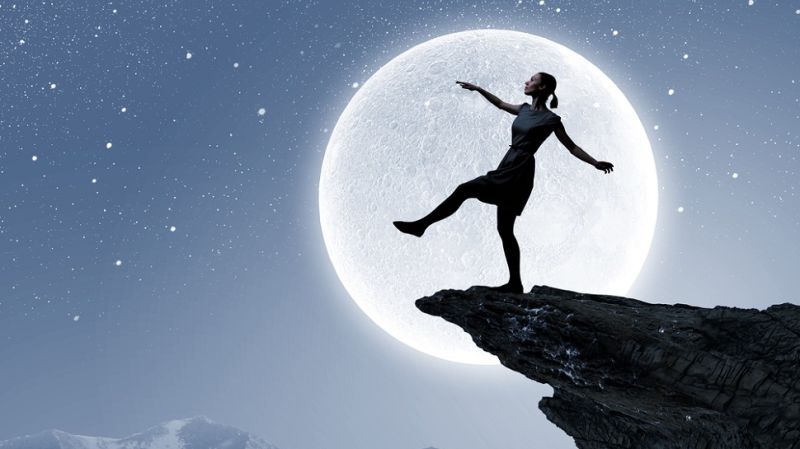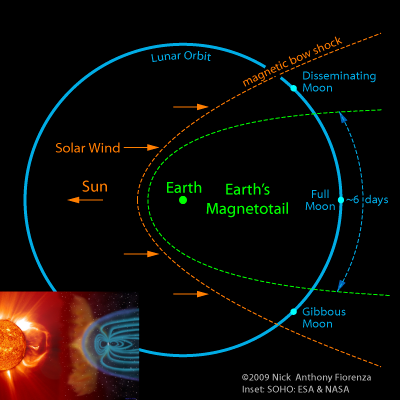Correlation of Haunt Phenomena with Moon Phase
by Vladimir Dubaj.
The moon has long been believed to hold some influence upon animal behavior. Pliny the Elder reasoned that the lunar force (now known as gravity) which pulls on the earth’s oceans may also exert similar effects on the water within the human body. This gravitational influence is now known to have minimal effect on human beings; the pull by the moon on the human body is no more than that of a brick wall when one stands a meter away. However, another mechanism which I have not been aware of until recently is the moon’s perturbation of the earth’s magnetic field.
As an active researcher of ghost (and haunting) activity, I was aware of the possibility of lunar influence on behavior via a “direct” moon-behaviour interaction. This influence could be exerted not by gravity but by psychology of expectation. However, I had never seriously considered the possibility of lunar influences on ghost activity. I had not come across any literature suggesting such lunar effects, nor was I aware of any causal link. Despite this, I was vigilant of possible psychogenic effects by individuals that provided me with reports of ghost activity. It is known that those with beliefs in the paranormal can also hold beliefs on the influence of the moon on behavior [1]. Such beliefs can contribute to cognitive biases that could lead to increased false reports during certain phases of the moon. However, during my research, I have not come across anyone who consciously linked their experiences with the moon phase.

Between 20-30% of the population is likely to experience, at some point in their lives, anomalous events commonly termed as ghost or haunting activity [2]. These experiences may occur across any sensory modality, ranging from visual, auditory, tactile and olfactory [3]. This is in addition to non-sensory processes such as feelings of a sensed presence and irrational fear, as well as witnessing direct interaction with the physical environment such as doors opening and objects moving seemingly of their own accord.
The moon-ghost interaction first became evident to me whilst I was analyzing a database of eye-witness statements pertaining to ghost and haunting activity. We had collated 20 years of data consisting of hundreds of reports. I decided to run an analysis between moon phase and frequency of reports. I had done this merely as a formality, expecting to find no relationship and put the idea to rest. However, the correlation came out to be highly significant. After brief contemplation, the most logical interpretation was a psychogenic one. Individuals’ attitudes and predispositions could have been influenced when observing the moon phase, consciously or otherwise, leaving raised expectation and imagination to do the rest.
Despite it’s large size however, the dataset could not clarify whether the effect was psychogenic or something more. The individuals in question were outdoors during both day or night, thus potentially being exposed to cues of moon phase. The finding did however prompt me to review my own personal dataset for similar patterns. Although my data set was much smaller in number, it had the advantage of being acquired under more controlled conditions. The possibility of psychological influences of the moon were much less likely.
I compiled 51 cases spanning several years. These comprised of 2 primary sources. The first consisted of investigations conducted by my group (22 cases). The field investigations were tightly controlled and the investigators were skeptical of lunar influences. Furthermore, the only evidence accepted during investigations was that witnessed by 2 or more investigators, or captured by our equipment. The second source consisted of a series of ghost/haunting phenomena reported by research participants and logged at the time of occurrence via SMS (29 cases). These SMS reports were followed up by personal communication to determine possible causes and influences. None of the individuals suggested the possibility of lunar influence.
Of the entire pool of 51 cases, 16 did not contain any unusual occurrences. These consisted of non-eventful field investigations. The remaining 35 cases contained unexplained occurrences spanning auditory, tactile and visual phenomena as well as direct influence of physical objects. Cases were grouped into 4 categories of moon phase: 0-25%, 26-50%, 51-75%, 76-100% visibility, and a frequency distribution was generated. Eventful data (those containing unusual occurrences) was found to be significantly skewed towards both New moon and Full moon periods. Non-eventful data showed no such pattern.
Although this was a smaller sample, the same pattern was observed here as for the much larger dataset that brought the lunar relationship to my attention in the first place. This supported my belief that the moon is linked in some way to the likelihood of experiencing ghost/haunting activity. Furthermore, the second data set suggested that there is more to ghost activity than wayward imagination.
One possible candidate mechanism for the moon’s influence on the earth is via modulation of the earth’s magnetosphere. Shaped by the solar wind, the magnetosphere is confined to about 10 earth radii on the day side of the earth, but extends well beyond the orbit of the moon at 60 earth radii. The lunar effects upon the earth’s geomagnetic activity has been shown by two mechanisms: 1) By physical interference with either the solar wind or the earth’s magnetosphere during new and full moon periods respectively [4-6]. 2) Gravitational forcing of the lower atmosphere; compressing and expanding the ionosphere [7, 8]. Both of these mechanisms have the effect of perturbing magnetic field activity which can be detected at ground level.

There is evidence that weak magnetic fields may be able to affect the human brain, particularly when the field is complex (more than a simple sinusoid). Michael Persinger has published numerous research papers providing evidence of magnetically induced changes in epileptiform activity [9, 10]. One avenue of his research has shown that temporal lobe activity in a subset of the normative population displays seizure-like activity, which does not manifest any physical symptoms. This group of individuals are more sensitive to magnetic field variations near their heads, being more likely to experience feelings of a sensed-presence. Professor Persinger also found an association between this non-seizure epileptiform-like activity and hallucinations [11]. There is also evidence of significant variations in clustering of seizures around moon phases [12-14], with seizures of the non-epileptic type being highest around the full moon quarter [15]. All this taken together lends support to the idea that at least a portion of individuals within the normative population may be more susceptible hallucinatory experiences when exposed magnetic field variations [10, 11, 16].
So the possibility exists that the moon plays a role in the probability of one experiencing ghost/haunting phenomena – namely via magnetic field perturbations affecting brain physiology. This could account for a proportion of sensory hallucinations which, by many, are assumed to be purely psychogenic. However, this mechanism is unlikely to explain instances of an apparition being observed by multiple witnesses, or cases where objects are physically moved of their own accord. Many insights are still waiting to be made.
1. Rotton, J. and I.W. Kelly, A scale for assessing belief in lunar effects: Reliability and concurrent validity. Psychological Reports, 1985. 57: p. 239-245.
2. Haraldsson, E., Alleged Encounters with the Dead: The Importance of Violent Death in 337 New Cases. Journal of Parapsychology, 2009. 73: p. 91-118.
3. Alvarado, C.S. and N.L. Zingrone, Characteristics of Hauntings With and Without Appritions: An Analysis of Published Cases. Journal of the Society for Psychical Research, 1995. 40(841): p. 385-397.
4. Akimov, L.A. and N.P. Dyatel, Influence of the moon on the earth’s magnetosphere at various phases of a solar activity cycle. Kinematics and Physics of Celestial Bodies, 2012. 28(1): p. 39-42.
5. Rangarajan, G.K., Lunar Semi-Monthly Variation in the Equatrial Electrojet Field in India. Geophys. J. R. astr. Soc., 1980. 61: p. 451-455.
6. Majmudar, N.H. and D.R.K. Rao, Characteristics of Pi2 pulsations at an equatorial station and its occurrence association with the phase of the Moon. Proc. Indian Acad. Sci (Earth Planet Sci.), 1983. 92(3): p. 217-222.
7. Lühr, H., T.A. Siddiqui, and S. Maus, Global characteristics of the lunar tidal modulation of the equatorial electrojet derived from CHAMP observations. Annales Geophysicae, 2012. 30(3): p. 527-536.
8. Gasperini, F. and J.M. Forbes, Lunar-solar interactions in the equatorial electrojet. Geophysical Research Letters, 2014. 41(9): p. 3026-3031.
9. Michon, A., S.A. Koren, and M.A. Persinger, Attempts to simulate the association between geomagnetic activity and spontaneous seizures in rats using experimentally generated magnetic fields. Percept Mot Skills, 1996. 82(2): p. 619-26.
10. Persinger, M.A., V. Hoang, and L. Baker-Price, Entrainment of stage 2 sleep spindles by weak, transcerebral magnetic stimulation in an “epileptic” woman. Electromagn Biol Med, 2009. 28(4): p. 374-82.
11. Persinger, M.A., Out-of-body-like experiences are more probable in people with elevated complex partial epileptic-like signs during periods of enhanced geomagnetic activity: a nonlinear effect. Percept Mot Skills, 1995. 80(2): p. 563-9.
12. Hadzic, D., et al., [The lunar cycle and seizures in children]. Med Glas (Zenica), 2010. 7(2): p. 137-42.
13. Polychronopoulos, P., et al., Lunar phases and seizure occurrence: just an ancient legend? Neurology, 2006. 66(9): p. 1442-3.
14. Ruegg, S., et al., Association of environmental factors with the onset of status epilepticus. Epilepsy Behav, 2008. 12(1): p. 66-73.
15. Benbadis, S.R., et al., The influence of the full moon on seizure frequency: myth or reality? Epilepsy Behav, 2004. 5(4): p. 596-7.
16. Persinger, M.A. and K.S. Saroka, Comparable proportions of classes of experiences and intracerebral consequences for surgical stimulation and external application of weak magnetic field patterns: implications for converging effects in complex partial seizures. Epilepsy Behav, 2013. 27(1): p. 220-4.
